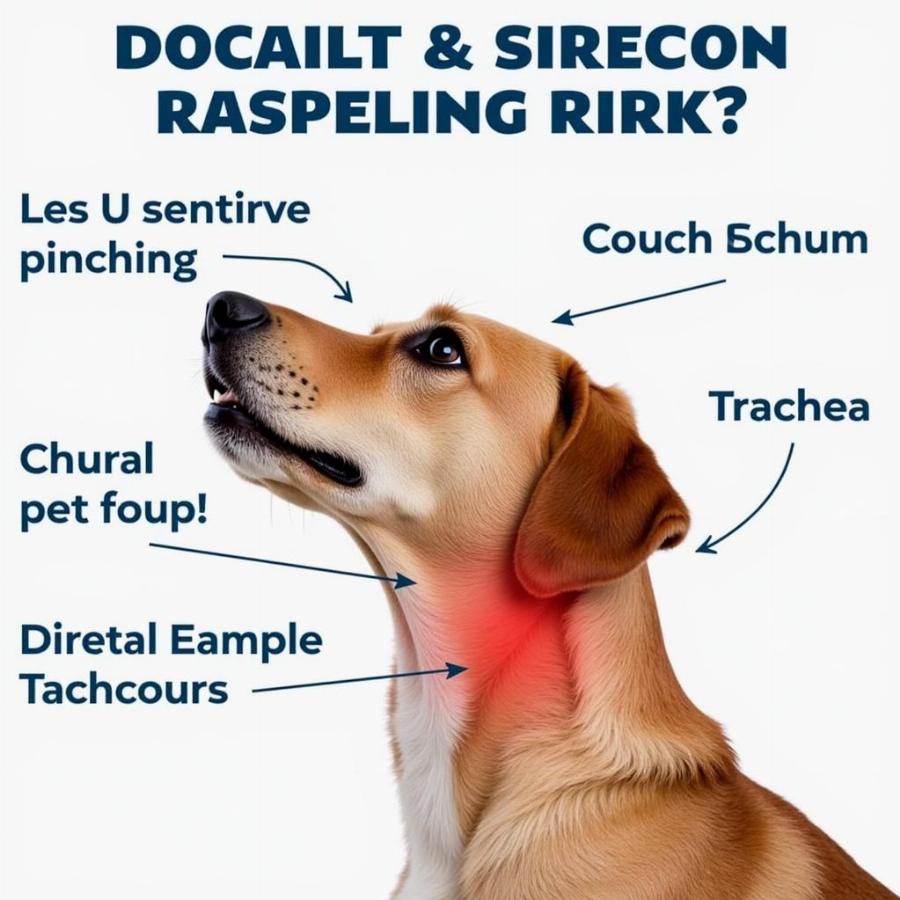Pinching a dog’s neck is a sensitive topic that often raises concerns among dog owners. While some traditional training methods may involve scruffing or pinching, it’s crucial to understand the potential risks and explore alternative, more humane approaches. This article delves into the nuances of touching a dog’s neck, differentiating between harmful pinching and appropriate handling for training and health checks.
Why Pinching a Dog’s Neck Can Be Harmful
Pinching a dog’s neck can cause pain and discomfort, especially if done incorrectly. The neck is a vulnerable area with delicate structures like the trachea and esophagus. Applying excessive pressure can lead to breathing difficulties, injury, and even behavioral problems stemming from fear and anxiety. Mother dogs may pick up puppies by the scruff, but this is a very specific action and differs significantly from pinching. Replicating this action with adult dogs can be misinterpreted and cause stress.
 Tác hại của việc bóp cổ chó
Tác hại của việc bóp cổ chó
Safe Ways to Handle Your Dog’s Neck
While pinching is discouraged, there are appropriate ways to handle your dog’s neck, particularly during veterinary examinations or when attaching a pinch dog collar. Gentle holding and supporting the neck, rather than pinching, is essential. For training purposes, using positive reinforcement methods and good training collars for dogs are much more effective and humane. Learning how to properly check for ticks and administer medication also involves careful handling of the neck area without causing any harm.
Alternatives to Pinching in Dog Training
Modern dog training emphasizes positive reinforcement and reward-based methods. These techniques focus on building a positive relationship with your dog and encouraging desired behaviors through rewards and praise. Aversive methods like pinching are unnecessary and can damage the bond between you and your pet. Instead, explore techniques like clicker training, lure-reward training, and shaping.
Training Collars and Harnesses: A Humane Approach
Instead of relying on pinching or other aversive methods, consider using appropriate training collars for big dogs or harnesses. A well-fitted harness distributes pressure evenly across the body, preventing strain on the neck. Consult with a certified dog trainer to determine the most suitable training tools and techniques for your dog’s breed, size, and temperament.
Preventing Neck Injuries in Dogs
Beyond avoiding pinching, understanding how to prevent neck injuries is vital for responsible dog ownership. Be mindful of your dog’s activities and ensure they avoid rough play that could strain their neck. Maintaining a healthy weight can also reduce the risk of how to prevent ivdd in dogs or Intervertebral Disc Disease, which can affect the neck and spine.
Conclusion
Pinching a dog’s neck can be detrimental to their physical and emotional well-being. Rather than resorting to outdated and potentially harmful methods, embrace positive reinforcement techniques and prioritize your dog’s comfort and safety. By understanding the proper ways to handle your dog’s neck and choosing appropriate training tools, you can build a stronger, more positive relationship with your furry companion.
FAQ
- Is it ever okay to scruff a dog? Generally, no. While mother dogs may scruff puppies, it shouldn’t be done with adult dogs.
- What are the signs of a neck injury in a dog? Signs can include whimpering, reluctance to move, and difficulty eating.
- What should I do if I accidentally pinch my dog’s neck? Monitor your dog for any signs of discomfort and consult a veterinarian if necessary.
- What are some effective positive reinforcement training techniques? Clicker training, lure-reward training, and shaping are excellent alternatives to aversive methods.
- How can I choose the right collar or harness for my dog? Consult with a certified dog trainer or veterinarian for personalized recommendations.
- How can I find a certified dog trainer? Search online directories or ask your veterinarian for referrals.
- What should I do if my dog exhibits aggressive behavior after being pinched? Consult with a professional dog behaviorist to address the underlying issues.
Beaut Dogs is your trusted resource for all things related to dog care, offering expert advice and valuable insights into the world of canine companionship. For personalized support and detailed answers to your questions, please contact us at Email: [email protected]. Let Beaut Dogs help you provide the best possible care for your beloved furry friend.